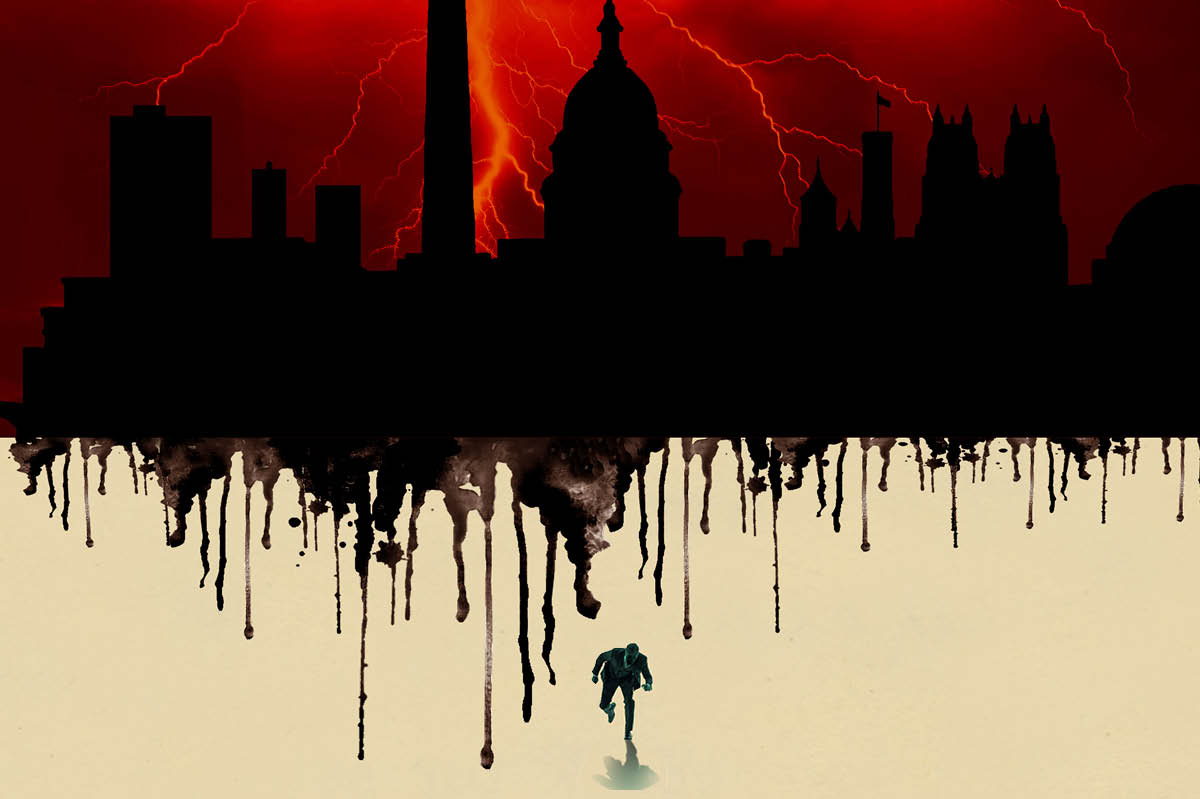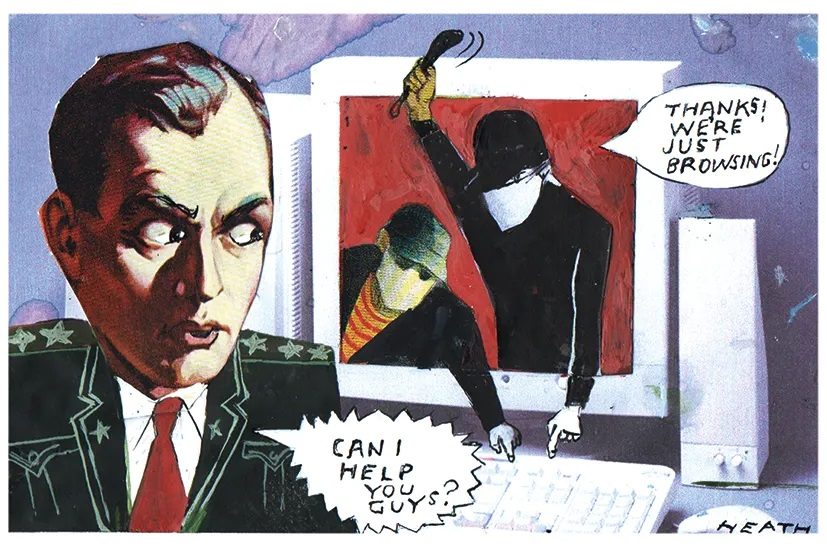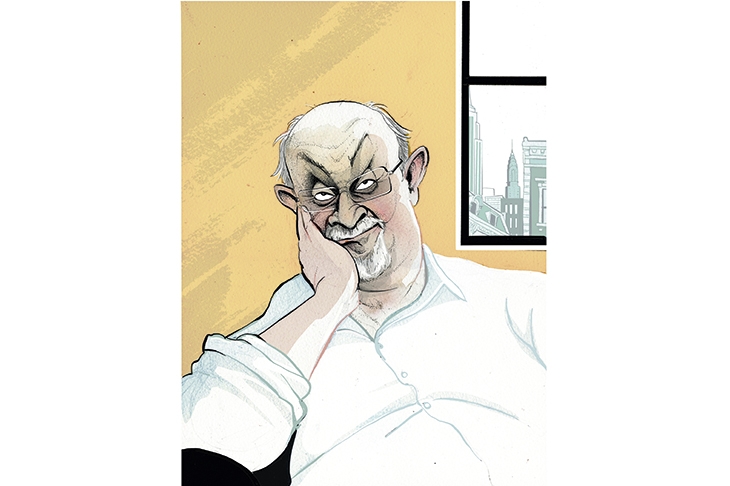The Social Security office in Detroit is a dispiriting place done up in industrial grays. It is filled with the long, glum faces of those who molder in the bowels of the federal bureaucracy waiting for some faceless bureaucrat to help them.
Take a number. Sit down. No loud noises. No food. No phones.
Into this purgatory enters Gus Malone, a raggedy 52-year-old homeless man, along with his invisible dog Timmy. Gus parades Timmy up and down the gray carpet of the waiting room as if it were the competition floor of the Westminster Kennel Club.
‘Good boy, Timmy!’ crows Gus upon reaching the far wall, making an ostentatious pivot on the soles of his secondhand sneakers and cantering Timmy back across the waiting room. He brings him to heel near the take-a-number machine. ‘Timmy, you’re a good boy!’
Here, Gus casts a sideways glance up at the government clerk who is sitting behind the bulletproof glass, wanting to be sure she is taking all this in. But it appears that imaginary dogs are as common at the Social Security office as daffodils in spring. The bureaucrat bats not an eyelash at the dog who is not there.
Gus has come to the Detroit office to file a disability claim with the federal government, hoping to hit the jackpot of all jackpots — $771 a month, every month, for the rest of his natural-born days.
Gus then admits that there really is no Timmy. It is a ruse that he characterizes as ‘playing crazy’. The invisible-dog bit may be the dollop of perceived schizophrenia that will fast-track his application directly to the top of the ‘approved’ basket.
‘I’m just a man trying to eat,’ says Gus to a woman with an oxygen tank sitting next to him. ‘I’m trying to eat, while not getting ate. Who it really hurt anyway?’ The lady nods knowingly toward him.
For all the electronic chatter about the comeback of Detroit, it is hard to see it here at the Social Security office, miles from the refurbished office towers of downtown where the artificial beach, deck chairs and outdoor cocktail stands have become something of a surrogate Puerto Vallarta for the skinny-jeaned millennials who work the cubicles there.
Out here in the real Detroit, where 650,000 of the poorest people in America live, no one seems to blame a guy for pulling the invisible-dog hustle. Out here in the other Detroit, the glass is perpetually nearly half-empty: nearly half the children live in poverty; average household income is nearly half that of the United States in general; nearly half the adults are functionally illiterate and consequently nearly half the adult population are not only unemployed, but they’re not even looking for a job.
Detroit has made some progress since the bad old days when both General Motors and the city itself went bankrupt and the mayor was sent to prison for lining his pockets with the public’s money. Today, the budget is balanced, condominiums are being built and thousands of people have moved downtown to live and work. Development is booming, much of it with substantial public subsides.
It’s welfare for the rich. Outside the downtown silk-stocking district, opportunities are few. A recent study of US Census data showed that while 31,000 jobs were created in Detroit between 2011 and 2016, most went to suburbanites. The number of Detroit residents who had jobs declined over the same period by 4,500. Every year, thousands of people get their water shut off for non-payment, and thousands more lose their houses due to tax foreclosure. Consequently, the Social Security office does a booming business. Native Detroiters — read black Detroiters — call this the Johannesburg model of development.
The Motor City is hardly alone. Nationwide, more than 8.5 million people of working age collect a federal disability check. The phenomenon has been dubbed the ‘disability-industrial complex’. Consider: more is paid for federal disability claims than for welfare and food stamps combined. It is into this army of have-nots that Gus hopes to enlist.
He rises early from bed beneath a picnic table in a newly refurbished park in Corktown, the epicenter of the white revival in downtown Detroit. ‘I like it in the white part of town,’ Gus says. ‘It’s safer.’
Indeed. For five years running, the populace has been fed a line that violent crime has been dropping annually. Yet Detroit remains the most violent city in America if the FBI numbers are to be believed.
The chief of police disputes those crime numbers, but ironically they were provided by the Detroit police department itself. Part of the crime problem lies in the fact that Detroit public safety has taken it on the chin since its historic bankruptcy in 2013, the largest municipal bankruptcy filing in the history of the United States. Police wages have not kept pace with inflation; medical benefits for retirees were slashed. And predictably, about half the police force have either resigned or retired over the past five years.
Leadership and discipline have suffered. A cop shot an innocent man several times last year during a manhunt for a baby-killer. A commander moonlighting as a security guard beat a St Paddy’s Day reveler into a coma. The former deputy chief of police was sentenced to a year in the federal penitentiary for accepting a $4,000 bribe which she claimed she had thought was a loan. Members of the narcotics squad have been caught stealing drugs and money from an evidence lock-up. In another episode, an undercover police crew brawled with another undercover police crew also posing as drug dealers.
So Gus flops in the white part of town. He awakes, ties his shoes, relieves himself in the bushes, puts a bristle to his gums and jumps aboard his stolen bicycle with the bent rear rim and the dog leash hanging from the handle bars.
Whatever his malady, Gus is vigorous. He manages to outpace the new trolley (built with taxpayer money) that serves downtown commuters. The trolley, however, has so few commuters that it is in jeopardy of going insolvent. A push to get taxpayers to save the service is under way.
Gus wobbles by the restaurant that features $100 steaks. But who can afford a $100 steak? Lots of restaurants popped up when the ‘Detroit Comeback’ was all the rage. Now many are closing.
It’s the same story in New York and Los Angeles and Seattle and San Francisco. The economy booms, the construction cranes jam the skylines while the homeless set up camp on the sidewalks and bathe in the public fountains. The public is appalled.
It is easy to dislike a man like Gus. He is, after all, a spectacle and a mooch, a deserter from the nine-to-five work world who characterizes his adult life as ‘the mop, the dishwashing machine, the crack stem and a few smashed windows’.
Still, there is something appealing about a man clucking lovingly to a leash with no dog on it. Gus manages to panhandle two bucks for some invisible-dog food.
In a town full of hustlers, Gus ranks right up there with the best that I’ve ever seen: Jesse, the fake disabled veteran who is said to have invented the wheelchair prop; Johnnie Dollar, the pool shark who met his end at the bottom of a frozen elevator shaft; Three-Card Jimmy, who worked the confidence game with just six fingers and two thumbs.
‘God bless,’ says Gus to the good Samaritan. He hops aboard his bike and continues his bike ride to the government office with Timmy in tow.
There goes City Hall. Mayor Mike Duggan is inside, hunkered down, beleaguered by scandals of his own making. One grand jury has been convened against the contractors associated with his administration; another has been proposed to investigate the activities of his staff. Both are in connection with the abuse of federal monies sent to Detroit to help tear down its spectacular blight. The investigations center on whether Duggan and his underlings swung multimillion-dollar contracts to his donors.
And now Duggan has been accused of swinging city contracts to his alleged girlfriend, a doctor who is said to be an expert in preterm births and infant mortality. After a private detective caught Duggan on video entering the doctor’s suburban home by way of an automatic garage-door opener, the press started asking questions. That’s when the mayor’s staff began destroying records that may have shown him granting her special favors.
People in Detroit, the largest majority African American city in the country, are now comparing Duggan to Kwame Kilpatrick, the former mayor who is serving 28 years in federal lock-up for public corruption. It’s worth noting that Duggan is white and Kilpatrick black. And so Detroit watches with a skeptical eye.
Gus pedals north, the rear tire wobbling, Timmy keeping pace. They pass an empty hole that consumes an entire city block. A skyscraper is supposed to go there, and the city sold the land at a knockdown price to billionaire businessman Dan Gilbert, who has also purchased 100 properties downtown. Gilbert is universally credited with turning downtown around with his $2 billion in cash infusions.
The problem is, Gilbert recently suffered a major stroke. Meanwhile, the skyscraper — also being built with hundreds of millions of dollars in public subsidies — has run into financing problems. Blueprints have not been finalized and construction cranes sit as idly as decorative lamps. And so the business community quietly worries about the sustainability of the so-called comeback.
Gus pedals on past the three sports stadiums that house all four of Detroit’s professional teams: the football Lions, the baseball Tigers, the hockey Red Wings and the basketball Pistons. The clubs are owned by billionaires, but the stadiums were built with public money. Yet the billionaires share minimal revenue with the city. To add insult to poverty, all four teams are unsuccessful and still make a handsome profit.
Meanwhile, back at the Social Security office: ‘Number 87!’ Gus’s number has been called. ‘You want to file for disability?’ asks the sleepy-eyed clerk.
‘Yes.’
‘Are you able to work online?’
‘I can’t read,’ says Gus.
‘Do you have ID?’
‘No. Sit Timmy!…I brought my dog Timmy with me too. Say hello to Timmy.’
‘Hello Timmy,’ says the clerk who for the first time looks up, only to find nothing. She taps lethargically into the computer before handing Gus an appointment slip for his intake interview, scheduled three weeks from today. By any measure, a reasonable outcome.
On their way to the door, Timmy takes a shit on the carpet. ‘Bad boy, Timmy!’ shouts Gus, who stoops over to pantomime the tidying-up of Timmy’s mess.
He turns one last time with a wave to the clerk. She waves back. A reasonable day indeed. That is, until Gus steps out into the chill to realize someone has stolen his stolen bike.
This article is in The Spectator’s December 2019 US edition.

























